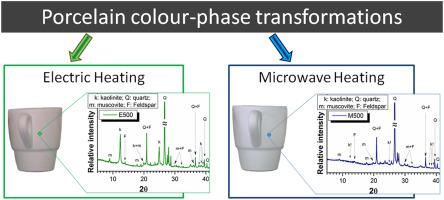Materials Chemistry and Physics ( IF 4.6 ) Pub Date : 2021-09-21 , DOI: 10.1016/j.matchemphys.2021.125265 T. Santos 1, 2 , L. Hennetier 3 , V.A.F. Costa 4 , L.C. Costa 1

|
Colour of microwave fired porcelain in a home-built multimode furnace is compared with electrically and gas (industrial) fired samples. Coffee cups were fired from room temperature up to slightly above 1400 °C using both heating technologies, presenting similar colour and functional properties. During firing, porcelain undergoes several transformations, with associated colour changes, which depend on the used heating technology. Results show that the colour of microwave fired samples is within the green-blue spectra, and that the colour of electrically fired samples is within the yellow-red spectra. Above the eutectic temperature of the K2O-Al2O3-SiO2 system, the colour of porcelain converges to the yellow-red spectra for any of the considered heating technologies. Microwave heating was found to promote faster crystallochemical transformations, which are responsible for the observed colour differences. This study aims a better understanding of microwave porcelain firing, focusing on the reasons behind the observed colour differences when comparing with conventional firing.
中文翻译:

微波与传统瓷器烧制:颜色分析
将自制多模式炉中微波烧制瓷器的颜色与电和气体(工业)烧制样品进行比较。咖啡杯使用两种加热技术从室温烧制到略高于 1400 °C,呈现出相似的颜色和功能特性。在烧制过程中,瓷器会经历多次转变,伴随着相关的颜色变化,这取决于所使用的加热技术。结果表明,微波烧制样品的颜色在绿-蓝光谱范围内,电烧样品的颜色在黄-红色光谱范围内。高于共晶温度的 K 2 O-Al 2 O 3 -SiO 2系统,对于任何考虑的加热技术,瓷器的颜色都会收敛到黄红色光谱。发现微波加热促进更快的晶体化学转变,这是观察到的颜色差异的原因。本研究旨在更好地了解微波瓷器烧制,重点关注与传统烧制相比观察到的颜色差异背后的原因。


























 京公网安备 11010802027423号
京公网安备 11010802027423号